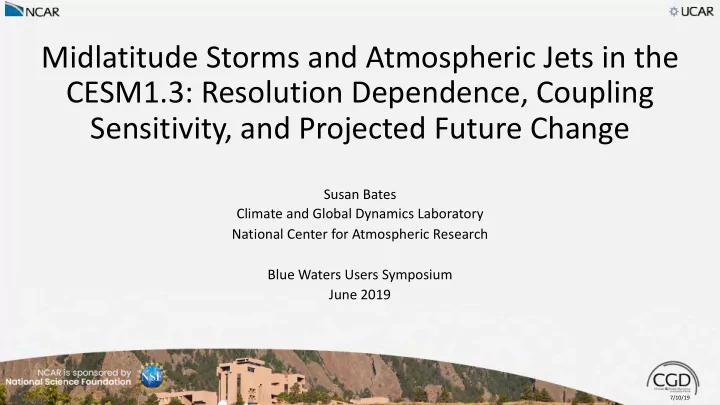

Midlatitude Storms and Atmospheric Jets in the CESM1.3: Resolution Dependence, Coupling Sensitivity, and Projected Future Change Susan Bates Climate and Global Dynamics Laboratory National Center for Atmospheric Research Blue Waters Users Symposium June 2019 7/10/19
CESM1.3 Simulations Fully-coupled 0.25° atmos/land - 1° ocn/ice • ~300M core-hours 0.25°atmos/land –only (30 years) 18.8M node-hours • 1 Pre-industrial control (200 yrs) ~70M core-hours • 4.4M node-hours • 1% CO2 and 4xCO2 (140 yrs) 4 present day (1979-2012) • • 3 Historicals (1850-2005) 8 future RCP8.5 scenarios (2070-2099) • • 3 future RCP2.6 (2006-2100) • 1 future RCP4.5 (2006-2100) 1°atmos/land –only (30 years) • 1 future RCP6.0 (2006-2100) 37K node-hours 596K core-hours • • 3 future RCP8.5 (2006-2100) 3 present day (1965-2005) • 3 future RCP8.5 scenarios (2070-2099) • Fully-coupled 0.25° atmos/land – 0.1° ocn/ice 12.5M node-hours • ~200M core-hours • 1 present-day control (135 yrs) Fully-coupled 1° atmos/land - 1° ocn/ice • 1 early century (2000-2005) 202K node-hours • 3.2M core-hours • 1 future RCP8.5 (2006-2100) • 1 Pre-industrial control (400 yrs) • 3 Historicals (1850-2005) • 1 PI control (500 yrs) • 3 future RCP8.5 (2006-2100) • 10 historical + RCP8.5 (1850-2100)
Present Day and Future ETC Storm Count 0.25° atmos/land only Global Pacific Storm Count per year (all storms) S. Hemisphere Atlantic Present Day 1983-2012 Present Day 1983-2012 (modified dust) Future RCP8.5 2070-2090 Future RCP8.5 2070-2090 (modified SST) Ensemble Member 7/10/19 3
Present Day and Future (0.25deg) Track Density Eddy Kinetic Energy (500mb) All storms Northern Hemisphere Future Present Day North Atlantic North Pacific Units are average hours per year in which a storm is found within a 4 o x 4 o gridbox Courtesy Rich N 7/10/19 4
Latitudinal Temperature Gradient (dT/dy) – 950mb 1° 0.25° Present Day Future Future-PD 7/10/19 5
Eady Growth Rate Eady Growth Rate Eady Eady 0.31 * g * |f| * |du/dz| 0.31 * g * |f| * |du/dz| Growth = Growth = (g/θ * dθ/dz) 1/2 (g/θ * dθ/dz) 1/2 Rate Rate 0.25° 0.25° 1° 1° Present Present Day Day Future-PD Future-PD 7/10/19 5/31/19 6 6
Eady Growth Rate Terms Vertical Wind Shear (du/dz) Vertical Temperature Gradient (dθ/dz) 1° 1° Present Day Future Eady increases Eady decreases Stability decreases Stability increases Future-PD 7/10/19 7
Zonal Wind at 850mb Northern Hemisphere 0.25° 1° colors = PD contours = future Future-PD 7/10/19 8
Southern Hemisphere Jet Assumption: higher horizontal resolution will produce better simulations of midlatitude storm systems, and thus improved representations of storm tracks • warmer base-state midlatitude sea surface temperatures (Small et al. 2018) • zonal structure is sensitive to both Tropical SST and teleconnections, as well as midlatitude SST gradients (Inatsu and Hoskins 2004) • the atmospheric jet stream and low cloud cover are related (Grise and Polvani 2014, Bony et al. 2015, Ceppi and Hartmann 2015). 7/10/19 9
Model Versions Coupled Uncoupled Physics Changes • 1x1_v1.1 • 1d_v1.3 • Dust tuning • Vertical advection • 0.25d_v1.1 • 1x1_v1.3 • Microphysics • 0.25d_v1.3 • 0.25x1_v1.3 • Gravity wave code • Bug fixes • 0.25x0.1_v1.2 • 1d_v1.3 • 0.25d_v1.1 • 0.25d_v1.3 7/10/19 10
Southern Hemisphere Jet – Eddy Kinetic Energy 1979-2005 JJA mean CESM1.3 CESM1.1 CESM1.1 CESM1.3 1x1 0.25x0.1 1x1 0.25x1 Same dynamics, different • resolution: EKE intensified Coupled when resolution increased Same resolution, different • dynamics: EKE intensified with better model physics Coupled vs. uncoupled: EKE • Atmos-only could be underestimated without air-sea interactions Resolution: degradation with • 0.1deg ocean, but different physics 7/10/19 11
Impact of Model Physics Low Cloud Fraction Temperature Gradient V1.3: more Equator to Pole Temperature Difference low clouds mostly in stratus regimes off west coasts and S.O. 7/10/19 12
Impact of Coupling Fully Coupled Atmosphere-only Equator to Pole Temperature Difference Differences due to resolution and physics. Differences due to resolution. 7/10/19 13
Summary • The number of midlatitude storms are predicted to decrease in the future due to a decrease in surface temperature gradient, vertical temperature gradient, and decrease in vertical wind shear. Results not sensitive to resolution in uncoupled simulation. • Higher resolution and better model physics do improve the representation of the Southern Hemisphere jet. • Degradation in model physics can override the improvement due to resolution. • The implications of this result are that simply improving resolution in atmosphere or ocean does not guarantee a better simulation of climate system dynamics. Instead, it is the combination of improved physics and improved resolution in the atmosphere that produce a better simulation of Southern Hemisphere storm tracks. 7/10/19 14
Vertical Wind Shear (du/dz) – 850mb 0.25° 1° PD Future Future-PD 7/10/19 15
Zonal Wind at 200mb 1° 0.25° colors = PD contours = future Future-PD colors = PD contours = future Future-PD 7/10/19 16
Latitudinal Sea Surface Temperature 7/10/19 17
Recommend
More recommend